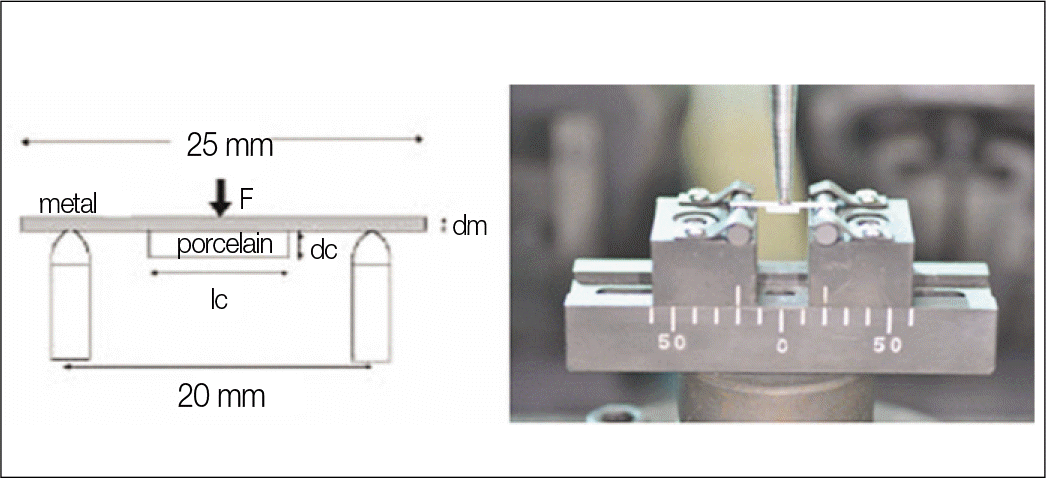Abstract
Purpose
In this study, we evaluated the bond-strength between a few metal ceramic-alloys and veneered-porcelain and found if the bond strength of metal-ceramic alloy with lower gold content than the presently used gold alloy was high enough.
Materials and methods
For this study, after plasticizing porcelain only for gold alloy, metal specimen was fabricated using Ni-Cr alloy and gold alloy with different gold content. Three point flexural test were performed to measure their bond-strength.
Results
The bonding strength of Group 1 to porcelain was 40.62 ± 3.32 MPa, which was the highest (P<.05). In sequence of decreasing value, Group 2 (75%) was 37.47 ± 1.57 MPa, Group 3 (52%) 35.85 ± 1.48 MPa, Group 4 (51.5%) 35.04 ± 1.34 MPa, Group 5 (32%) 33.17 ± 1.62 MPa, Group 6 (10%) 30.75 ± 1.21 MPa. Bonding strength of Group 3 and Group 4 to porcelain did not show statistically significant difference with comparison to that of Group 5 (Duncan's test, P>.05), while there was a significant difference between that of Group 2, Group 3 and Group 4 and that of Group 6 (Duncan's test, P<.05). The bonding strength between gold alloy and porcelain increased according to the content of gold. In all experimental groups showed higher value than 25 MPa, which is the least value recommended by ISO 9693.
Go to : 
REFERENCES
1.Bagby M., Marshall SJ., Marshall GW Jr. Metal ceramic compatibility: a review of the literature. J Prosthet Dent. 1990. 63:21–5.

2.Dent RJ., Preston JD., Moffa JP., Caputo A. Effect of oxidation on ceramometal bond strength. J Prosthet Dent. 1982. 47:59–62.

3.Moffa JP. Alternative dental casting alloys. Dent Clin North Am. 1983. 27:733–46.
4.Moffa JP., Lugassy AA., Guckes AD., Gettleman L. An evaluation of nonprecious alloys for use with porcelain veneers. Part I. Physical properties. J Prosthet Dent. 1973. 30:424–31.

5.Kelly JR., Rose TC. Nonprecious alloys for use in fixed prosthodontics: a literature review. J Prosthet Dent. 1983. 49:363–70.

6.Rosenstiel SF., Land MF., Fujimoto J. Contemporary Fixed Prosthodontics. 3rd ed.St. Louis: Mosby;2001. p. 488–512.
7.International Standard Organization (ISO)/DIS 9693 (1999) Dental ceramic fused to metal restorative materials. Draft International Standard.
8.Knap FJ., Ryge G. Study of bond strength of dental porcelain fused to metal. J Dent Res. 1966. 45:1047–51.

9.Shell JS., Nielsen JP. Study of the bond between gold alloys and porcelain. J Dent Res. 1962. 41:1424–37.

10.Anusavice KJ., Dehoff PH., Gray A., Lee RB. Delayed crack development in porcelain due to incompatibility stress. J Dent Res. 1988. 67:1086–91.

11.Pro ¨bster L., Maiwald U., Weber H. Three-point bending strength of ceramics fused to cast titanium. Eur J Oral Sci. 1996. 104:313–9.

12.Atsu ¨ S., Berksun S. Bond strength of three porcelains to two forms of titanium using two firing atmospheres. J Prosthet Dent. 2000. 84:567–74.
13.Yilmaz H., Dinçer C. Comparison of the bond compatibility of titanium and an NiCr alloy to dental porcelain. J Dent. 1999. 27:215–22.

14.De′rand T., Her� H. Bond strength of porcelain on cast vs. wrought titanium. Scand J Dent Res. 1992. 100:184–8.
15.Pang IC., Gilbert JL., Chai J., Lautenschlager EP. Bonding characteristics of low-fusing porcelain bonded to pure titanium and palladium-copper alloy. J Prosthet Dent. 1995. 73:17–25.

16.Wight TA., Bauman JC., Pelleu GB Jr. An evaluation of four variables affecting the bond strength of porcelain to nonprecious alloy. J Prosthet Dent. 1977. 37:570–7.

17.Guinn JW 3rd., Griswold WH., Vermilyea SG. The effect of cooling rate on the apparent bond strength of porcelain-metal couples. J Prosthet Dent. 1982. 48:551–4.

18.Schaffer SP. An approach to determining the bond strength of ceramometal systems. J Prosthet Dent. 1982. 48:282–4.

19.Caputo AA., Dunn B., Reisbick MH. A flexural method for evaluation of metal-ceramic bond strengths. J Dent Res. 1977. 56:1501–6.

20.Anusavice KJ., Dehoff PH., Fairhurst CW. Comparative evaluation of ceramic-metal bond tests using finite element stress analysis. J Dent Res. 1980. 59:608–13.
21.Lenz J., Schwarz S., Schwickerath H., Sperner F., Scha ¨fer A. Bond strength of metal-ceramic systems in three-point flexure bond test. J Appl Biomater. 1995. 6:55–64.

22.Barghi N., Lorenzana RE. Optimum thickness of opaque and body porcelain. J Prosthet Dent. 1982. 48:429–31.
23.Adachi M., Mackert JR Jr., Parry EE., Fairhurst CW. Oxide adherence and porcelain bonding to titanium and Ti-6Al-4V alloy. J Dent Res. 1990. 69:1230–5.
24.Kaus T., Pro ¨bster L., Weber H. Clinical follow-up study of ceramic veneered titanium restorations—three-year results. Int J Prosthodont. 1996. 9:9–15.
25.Kimura H., Horng CJ., Okazaki M., Takahashi J. Effects of retention and bonding agent on bond strength of the titanium porcelain system. J Osaka Uni Dent Sch. 1991. 31:23–32.
26.Hsu CC., Lee YP., Hong CC. Effects of different ceramic firing cycles on cp Titanium-Ceramic flexural bond strength under cyclic fatigue loading. [IADR abstract 1088] J Dent Res. 2001. 80:(special issue).
27.McLean JW. Dental ceramics. Chicago: Quintessence;1983. p. 13–49.
28.Kvam K., Derand T., Austrheim EK. Fracture toughness and flexural strength of dental ceramics for titanium. Biomaterials. 1995. 16:73–6.

29.Esquivel JF., Chai J., Wozniak WT. The physical properties of low-fusing porcelains for titanium. Int J Prosthodont. 1996. 9:563–71.
Go to : 
 | Fig. 1.Scheme of the 3-point flexure test (the dimension of the test configuration are given by lc = 8 mm, dm = 0.5 mm, dc = 1 mm). |
Table 1.
Metal-Ceramic alloys used for this study
Table 2.
Mean values of 3-point flexure test results and Duncan's multiple range test letter codes for groups (Unit: MPa)
| Group | N | Mean ± SD | Duncan's grouping |
|---|---|---|---|
| 1 | 5 | 40.62 ± 3.32 | A |
| 2 | 5 | 37.47 ± 1.57 | A B |
| 3 | 5 | 35.85 ± 1.48 | B C |
| 4 | 5 | 35.04 ± 1.34 | B C |
| 5 | 5 | 33.17 ± 1.62 | C D |
| 6 | 5 | 30.75 ± 1.21 | D |
| Total | 30 | 35.48 ± 3.58 |




 PDF
PDF ePub
ePub Citation
Citation Print
Print


 XML Download
XML Download